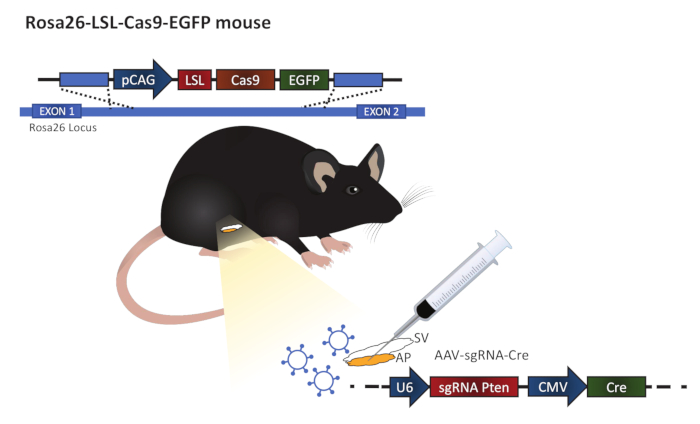A subscription to JoVE is required to view this content. Sign in or start your free trial.
Modeling Prostate Cancer in Genetically-engineered Mouse Models: A CRISPR/Cas9-mediated Localized Gene Editing Technique in Mouse Anterior Prostate Lobe Cells
Overview
This video describes a method for editing specific genes in prostate gland cells using an adenovirus-based delivery system. The approach allows for orthotopic and localized alteration of gene expression utilizing CRISPR technology to develop novel mouse models for prostate cancer.
Protocol
All procedures involving animal models have been reviewed by the local institutional animal care committee and the JoVE veterinary review board.
1. Virus-delivery to the Murine Prostate
- Anesthetize the animal by intraperitoneal injection with a sterile 1 mL syringe and a 27G x ½" needle. Use an anesthesia dose of 0.01 mL/g body weight. If the procedure lasts longer than 30 min, maintain anesthesia by injecting 1/3 of the starting dose every 30 min. <.......
Representative Results

Figure 1: Illustration of the procedure. The procedure is carried out in the Rosa26-LSL-Cas9-EGFP mouse generated by Platt et al. The anterior prostate (AP) is attached to the seminal vesicle (SV). Virus particles expressing guide RNA and a Cre protein are injected into the anterior prostate to alter gene expression.
Reprints and Permissions
Request permission to reuse the text or figures of this JoVE article
Request PermissionThis article has been published
Video Coming Soon
Source: Riedel, M. et al. Virus Delivery of CRISPR Guides to the Murine Prostate for Gene Alteration. J. Vis. Exp. (2018)
ABOUT JoVE
Copyright © 2025 MyJoVE Corporation. All rights reserved